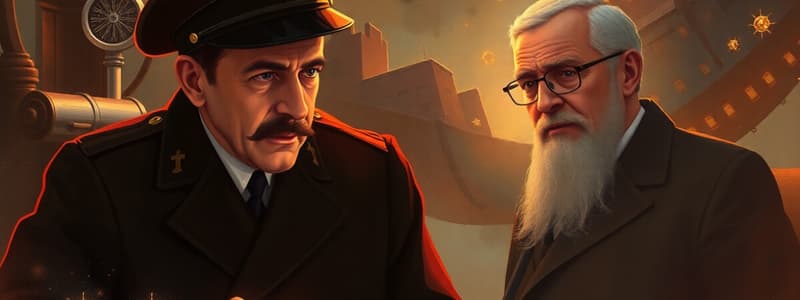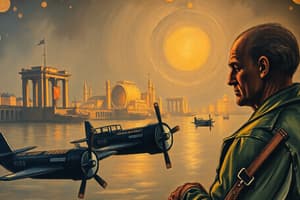Podcast
Questions and Answers
Which scientist's work significantly contributed to reconciling the principles of genetics with Darwin's theory of evolution?
Which scientist's work significantly contributed to reconciling the principles of genetics with Darwin's theory of evolution?
- Linus Pauling
- Werner Heisenberg
- Theodosius Dobzhansky (correct)
- Wolfgang Pauli
Whose research directly contributed to advancements against specific viral diseases during and after World War II?
Whose research directly contributed to advancements against specific viral diseases during and after World War II?
- John von Neumann
- Wendell Stanley (correct)
- Kathleen Lonsdale
- Howard Aiken
Which scientist's work is fundamental to our understanding of atomic structure and the behavior of electrons within atoms?
Which scientist's work is fundamental to our understanding of atomic structure and the behavior of electrons within atoms?
- Theodosius Dobzhansky
- Linus Pauling
- Wolfgang Pauli (correct)
- Werner Heisenberg
Whose theoretical contributions are central to the Copenhagen interpretation and the uncertainty principle in quantum mechanics?
Whose theoretical contributions are central to the Copenhagen interpretation and the uncertainty principle in quantum mechanics?
Who is credited with developing a computer architecture that forms the basis of all modern computers?
Who is credited with developing a computer architecture that forms the basis of all modern computers?
Which scientist pioneered X-ray crystallography techniques to determine the structure of molecules, including benzene?
Which scientist pioneered X-ray crystallography techniques to determine the structure of molecules, including benzene?
Which scientist's work, documented in 'The Nature of the Chemical Bond,' revolutionized the understanding of chemical bonds, especially in covalent compounds?
Which scientist's work, documented in 'The Nature of the Chemical Bond,' revolutionized the understanding of chemical bonds, especially in covalent compounds?
Who developed a model that explains the electrical and thermal properties of metals, based on the behavior of electrons?
Who developed a model that explains the electrical and thermal properties of metals, based on the behavior of electrons?
Who led the development of the Harvard Mark I, an early electromechanical computer that demonstrated the potential of programmable machines?
Who led the development of the Harvard Mark I, an early electromechanical computer that demonstrated the potential of programmable machines?
Which scientist's work first proposed the existence of the neutrino, a subatomic particle?
Which scientist's work first proposed the existence of the neutrino, a subatomic particle?
Flashcards
Wolfgang Pauli
Wolfgang Pauli
A physicist known for the Pauli exclusion principle.
Pauli exclusion principle
Pauli exclusion principle
States no two electrons in an atom can be in the same state.
Theodosius Dobzhansky
Theodosius Dobzhansky
Geneticist who linked genetics with evolution.
Howard Aiken
Howard Aiken
Signup and view all the flashcards
Heisenberg uncertainty principle
Heisenberg uncertainty principle
Signup and view all the flashcards
Linus Pauling
Linus Pauling
Signup and view all the flashcards
Kathleen Lonsdale
Kathleen Lonsdale
Signup and view all the flashcards
John von Neumann
John von Neumann
Signup and view all the flashcards
Wendell Stanley
Wendell Stanley
Signup and view all the flashcards
Nobel Prize in Physics 1945
Nobel Prize in Physics 1945
Signup and view all the flashcards
Study Notes
World War II Research Funding
- Governments increased funding for research during WWII, hoping to gain tactical advantages
- Intense competition among scientists led to new discoveries, impacting both military and civilian life after the war
- Research continued after the war ended
Wolfgang Pauli
- Austrian-born Swiss and American theoretical physicist
- Known for his work on atomic structure and the Pauli exclusion principle
- This principle states no two electrons in an atom can occupy the same quantum state simultaneously
- Also created a model that explained the properties of metals
- He was the first to propose existence of a subatomic particle called the neutrino
- Awarded the Nobel Prize in Physics in 1945.
Theodosius Dobzhansky
- Russian population geneticist
- A central figure in evolutionary biology
- Born in Ukraine, emigrated to the US in 1927
- Extensive work with fruit flies helped bridge the gap between genetics and evolution
- Showed mutations created genetic diversity, providing the raw material for natural selection
- Helped reconcile genetic findings with Darwin's theory of evolution
Howard Aiken
- American electrical engineer
- Built the Harvard Mark I computer in 1944
- A part-electric, part-mechanical computer used during WWII
- Demonstrated programmable machines could solve large-scale problems automatically
- Helped pave the way for modern computers, working alongside Grace Hopper
- Helped develop computer programming methods
Werner Heisenberg
- Born in Würzburg, Germany, in 1901
- Studied mathematics and physics at universities in Munich and Göttingen.
- Met his future collaborator Niels Bohr in Göttingen in 1922
- Known for his work on the Copenhagen interpretation (quantum systems governed by probability rules)
- Contributed to the uncertainty principle and quantum field theory
- Developed his own theory of antimatter
- Received the 1932 Nobel Prize in Physics for his work on quantum mechanics (youngest recipient)
Linus Pauling
- Chemist born in Portland, Oregon
- Winner of two Nobel Prizes—one in Chemistry and one for Peace
- Contributed to quantum mechanics in early chemistry
- Influential chemistry textbook author, "The Nature of the Chemical Bond"
- Developed rules for determining the structure of ionic crystals
- Explained atomic orbitals in covalent compounds
- Described how atomic orbitals combine to form molecular orbitals
Kathleen Lonsdale
- Worked under William Henry Bragg at the Royal Institution, London
- Developed X-ray techniques for studying chemical compound structures
- Found that carbon atoms in benzene are arranged in a hexagonal ring
- Applied X-ray crystallography to study bladder stones and drugs
- Became a fellow of the Royal Society in 1945, one of two women elected at the time.
John von Neumann
- Brilliant Hungarian-born mathematician
- Worked on early high-speed electronic digital computers
- Collaborated with American meteorologist Jule Charney to develop computer-based weather prediction methods.
- Developed a model for modern computers that could store both data and programs (Von Neumann architecture)
Wendell Stanley
- Born in Indiana
- Determined the molecular structure of viruses using X-ray diffraction
- Shared the 1946 Nobel Prize in Chemistry for his research on the tobacco mosaic virus
- Provided insights into viruses as causes of infectious diseases during WWII.
- Critically contributed to developing a vaccine against influenza
- Played a part in enabling the development of a polio vaccine.
Studying That Suits You
Use AI to generate personalized quizzes and flashcards to suit your learning preferences.




